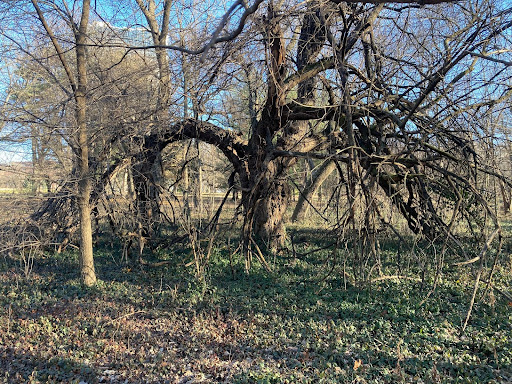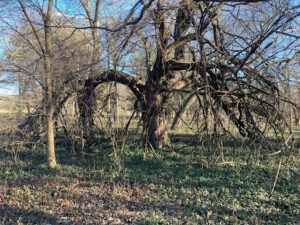By: Mark Halpin
Forestry Manager
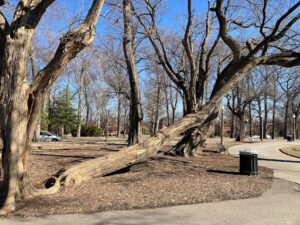 Some trees are begging to be climbed, and some are begging to be walked up…
Some trees are begging to be climbed, and some are begging to be walked up…
Anyone who has been to the Tower Grove Music Stand, next to the Piper Palm House in Tower Grove Park, has surely noticed what is possibly one of the crookedest trees on the planet. This Osage orange (Maclura pomifera) has appeared to be on the very brink of failure for at least a decade; if it were leaning any more it would be laying on the ground.. People walk up onto it, sit on it, hang on it and lean against it, and yet that exquisitely acute angle between tree and earth never grows smaller. If it ever does fail, it will be the most anticlimactic collapse imaginable.
Tower Grove is home to some of the most gorgeous Osage orange specimens imaginable, many of which were planted during Henry Shaw’s lifetime, making them ~150 years old. Whether or not this tree is that old is impossible to say. Looking at the picture below, we can see that it appears to have split in half and is missing some internal wood, so an accurate tree ring count would be impossible. I would venture a guess that it is in fact a remnant of one of the original Shaw trees, a multi-stem tree that failed at some point and most of which has been cleared away and long forgotten. What remains is the Last Man Standing, if you can call this “standing”.
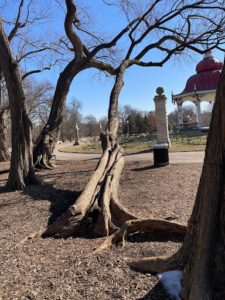 Trace the wound from the roots to the upper right portion, and you can see where a former, long-since dead stem was cut off.
Trace the wound from the roots to the upper right portion, and you can see where a former, long-since dead stem was cut off.
Note how the live wood at the bottom left just above the ground looks like twisted rope.
The question that naturally enters our minds when we see a tree like this, is “what is holding it up?” The answer is the arboricultural phenomenon known as “reaction wood”. It can be observed even in trees that are relatively perpendicular to the ground, but exposed to heavy winds: the tree’s growth adjusts to compensate for the force. In coniferous trees, reaction wood usually takes the form of “compression wood” and in angiosperms like our Osage orange here, it is “tension wood.” Compression wood essentially props the tree up from underneath the lean, whereas tension wood holds it up by, you guessed it, tension. Anyone who has ever had to place a tall ladder against the side of a building can appreciate how difficult a job this is. You are at a mechanical disadvantage and much force must be exerted, regardless of whether it is tension or compression.
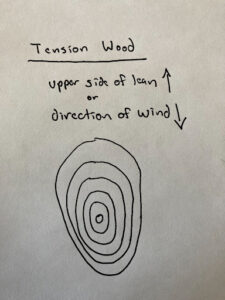 “Artist’s” rendering of tension wood – the tree rings grow wider on the tension-giving side. If you look at a stump or “tree cookie” you will notice that the rings are almost always wider on one side than the other – this is an indication of either the tree’s lean and/or the direction of the wind. The wide rings are the tension wood itself.
“Artist’s” rendering of tension wood – the tree rings grow wider on the tension-giving side. If you look at a stump or “tree cookie” you will notice that the rings are almost always wider on one side than the other – this is an indication of either the tree’s lean and/or the direction of the wind. The wide rings are the tension wood itself.
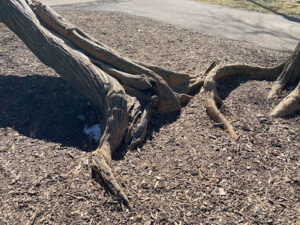 Tense? I’m not tense!!
Tense? I’m not tense!!
Imagine the crude, childlike drawing above superimposed onto this tree’s base, and note how the tension wood area here is mostly occupied by dead wood, or by nothing at all. Those narrow bands of live wood on either side (with the stripey orange bark) are the only things holding this tree up. This tissue connects to the woody cables of the root system, which branch out into ever smaller segments, finally into tiny hair roots, all spreading out like a spider web into the soil. If you’ve ever attempted to pull a small tree seedling from your garden bed you can appreciate how strong a root system can grip. Multiply that by a few thousand times and you can begin to understand how this tree is still not touching the ground.
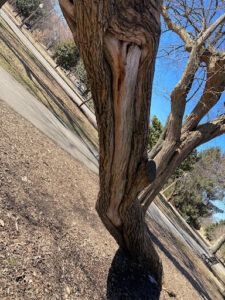 You hold 16 tons, what do you get?
You hold 16 tons, what do you get?
Osage orange wood weighs 54lbs. per cubic feet – I think a conservative estimate of this tree’s weight would be 1,600lbs. At this angle the weight is multiplied roughly 20 times, meaning its root system is supporting the equivalent of 16 tons with its tensile force (yes, I adjusted my estimate a little to reference Merle Travis’s classic song. It’s still pretty accurate!). What else is there to say? To think a bunch of roots and dirt can hold the weight of 4 cars, 1.5 mature African bush elephants, or 27 horses is pretty staggering.
Trees are cool.

